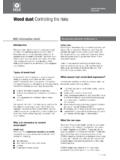Transcription of Guidance for Controlling Potential Risks to …
1 Guidance for Controlling Potential Risks toWorkers Exposed to Class B BiosolidsThis Guidance is intended only for Controlling health Risks to workers fromClass B biosolids during handling and land application. This Guidance is notintended to address nonoccupational OF HEALTH AND HUMAN SERVICESC enters for Disease Control and PreventionNational Institute for Occupational Safety and HealthJuly 2002 SAFER,HEALTHIER,PEOPLEDISCLAIMERM ention of any company or product does not constituteendorsement by INFORMATIONTo receive documents or more information about occupationalsafety and health topics, contact the National Institute forOccupational Safety and Health (NIOSH)
2 AtNIOSH Publications Dissemination4676 Columbia ParkwayCincinnati, OH 45226 1998 Telephone:1 800 35 NIOSH(1 800 356 4674)Fax: 1 513 533 8573E-mail: visit the NIOSH Web site Number 2002 149 This document is in the public domainand may be freely copied or are the organic residues resulting fromthe treatment of commercial, industrial, andmunicipal wastewater (sewage). One purposeof the treatment is to significantly reduce theconcentration ofdisease-causing organisms (alsoknown as pathogens). Treatment also reducesthe attractiveness of the residues to insects,birds, and rodents.
3 The product is a materialthat can be recycled for uses such as addingorganic material to the Environmental Protection Agency (EPA)has established two categories of biosolids: Class A biosolids have undergone treat-ment to the point where the concentrationof pathogens is reduced to levels low enoughthat no additional restrictions or special han-dling precautions are required by Federalregulations [40 CFR*Part 503]. If the Class Abiosolids meetexceptional qualityrequire-ments for metals content, they may besold in bags and applied in the same wayas other soil conditioners such as peatmoss.
4 Class B biosolids have undergone treatmentthat has reduced but not eliminated patho-gens. By definition, Class Bbiosolids maycontain pathogens. As a result, Federal reg-ulations for use of Class B biosolids requireadditional measures to restrict public accessand to limit livestock grazing for specifiedtime periods after land application [40 CFRPart 503]. This allows time for the naturaldie-off of pathogens in the EPA rules [40 CFR Part 503] restrictpublic access to lands treated with Class Bbiosolids in order to protect public health, theserules do not apply to workers involved withClass B biosolids handling and land application.
5 *Code of Federal may come in contact with Class Bbiosolids during the course of their work. Workersand employers may be well aware of the needfor precautions when contacting untreated sew-age but less aware of the need for basic precau-tions when using Class B biosolids. This docu-ment provides information, Guidance , andrec-ommendations to employers and employees work-ing with Class B biosolids to minimize occupa-tional Risks from pathogens. It does not addressother Potential safety and health issues such asinjuries or exposures to are biosolids used?
6 Biosolids are typically treated to Class B orClass A standards at the wastewater (sewage)treatment plant, where a liquid or semi-solidmaterial is produced. In a liquid state, biosolidscan be transported by truck to a land applica-tion site where they are applied directly tothe land using tractors, tank wagons, irrigationsystems, orspecial application vehicles. Alter-natively, biosolids may undergo mechanicaldewatering that may include the use of poly-mers. Dewatered and liquid biosolids are oftentemporarily stored at the treatment plant orapplication site.
7 Dewatered biosolids are trans-ported and applied to land using front-end load-ers,trucks, tractors, or biosolids-spreading equip-ment. Most biosolids are applied with spreadersin semisolid form and then incorporated into thesoil using a disc plow. Workers may come intoeither direct or indirect contact with biosolidsduring any phase of the treatment, transport, orapplication process, or after they are land ap-plied. Currently, more than 50% of the biosolidsgenerated in the United States is recycled as soilconditioners to improve and maintain productivesoils and stimulate plant growth rather than beingsent to landfills or incinerated.
8 Biosolids are ap-plied on agricultural land, forestlands, and sur-face mine reclamation sites. Class A biosolidsare also used in horticultural applications. EPAestimates that million tons of biosolids weregenerated for use or disposal in is in biosolids thatrequires control of workerexposures?There are four major types of human disease-causing organisms (pathogens) that can be foundin sewage: (1) bacteria, (2) viruses, (3) protozoa,and (4) helminths (parasitic worms). Class Bbiosolids may contain the same types of patho-gens as the source sewage, but at reduced con-centrations.
9 Both Class A and Class B biosolidsmay also contain chemicals (including metals)and protect public health, the EPA s 40 CFRPart 503 rule prescribes arestricted periodofup to 1 year to limit public access to landswhere Class B biosolids have been EPA restrictions do not apply to occupa-tional access. EPA does recognize that occupa-tional exposure can occur and states that workersexposed to Class B biosolids might benefit fromseveral additional precautions such as use ofdust masks when spreading dry materials, theuse of gloves when touching biosolids, and rou-tine hand washing before eating, drinking, smok-ing, or using the risk of worker exposure to infectious agentsin Class B biosolids is likely greatest prior to,during, and immediately after land applicationof the biosolids.
10 Because the concentration ofpathogens declines through natural processes,the Potential for pathogen exposure decreasesover we know thesepathogens can causedisease?Yes, the association between poor hygiene, rawsewage, and infectious disease is well estab-lished. Most of the pathogenic bacteria, viruses,and parasites in biosolids are enteric, whichmeans they are present in the intestinal tracts ofhumans and animals. Enteric organisms that maybe found in biosolids include, but are not limitedto,Escherichia coli,Salmonella, Shigella,Campylobacter, Cryptosporidium, Giardia, Norwalkvirus, and enteroviruses.
















